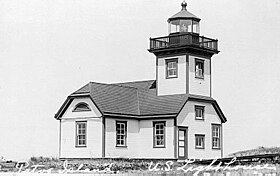 | |
 | |
| Location | San Juan Islands, Washington |
|---|---|
| Coordinates | 48°47′20″N122°58′17″W / 48.789°N 122.9715°W [1] |
| Tower | |
| Foundation | Surface |
| Construction | Wood |
| Automated | 1974 |
| Height | 38 feet (12 m) |
| Shape | Square |
| Heritage | National Register of Historic Places listed place |
| Light | |
| First lit | 1908 |
| Focal height | 12 m (39 ft) |
| Lens | Fourth order Fresnel lens |
| Range | 9 nmi (17 km; 10 mi) (white), 6 nmi (11 km; 6.9 mi) (red) |
| Characteristic | White light every 6 s; two red sectors marking dangerous shoals |
Patos Island Light Station | |
| Nearest city | Eastsound, Washington |
| Area | 1 acre |
| Built | 1893 |
| Architectural style | Greek Revival-Victorian |
| NRHP reference No. | 77001355 [2] |
| Added to NRHP | October 21, 1977 |
Patos Island Lighthouse is an active aid to navigation overlooking the Strait of Georgia at Alden Point on the western tip of Patos Island in the San Juan Islands, San Juan County, Washington, in the United States. [3] The station is the northernmost in the San Juan Islands and marks the division point between the eastern and western passages into the Strait of Juan de Fuca. [4]
Contents
In 2013, Patos Island and its lighthouse were included in the US Presidential Proclamation [5] by Barack Obama creating San Juan Islands National Monument, [6] managed by the Bureau of Land Management, part of the US Department of Interior. Limited developments on the island are managed in partnership with Washington State Parks and volunteers with the nonprofit friends group Keeper of the Patos Light. [7] On some maps it is also referred to as Patos Island State Park. [8]
Access to Patos Island is challenging; no public ferry system serves the 200 acre island. Two offshore mooring buoys are available for private boats as permitted through the Washington State Parks. [9] The volunteer organization Keepers of the Patos Light provides some public access to the lighthouse structure during summer months in partnership with the Washington State Parks and Bureau of Land Management, and have developed interpretive exhibits for the lighthouse through a Washington State Lighthouse Environmental Program (LEP) grant. [7]


